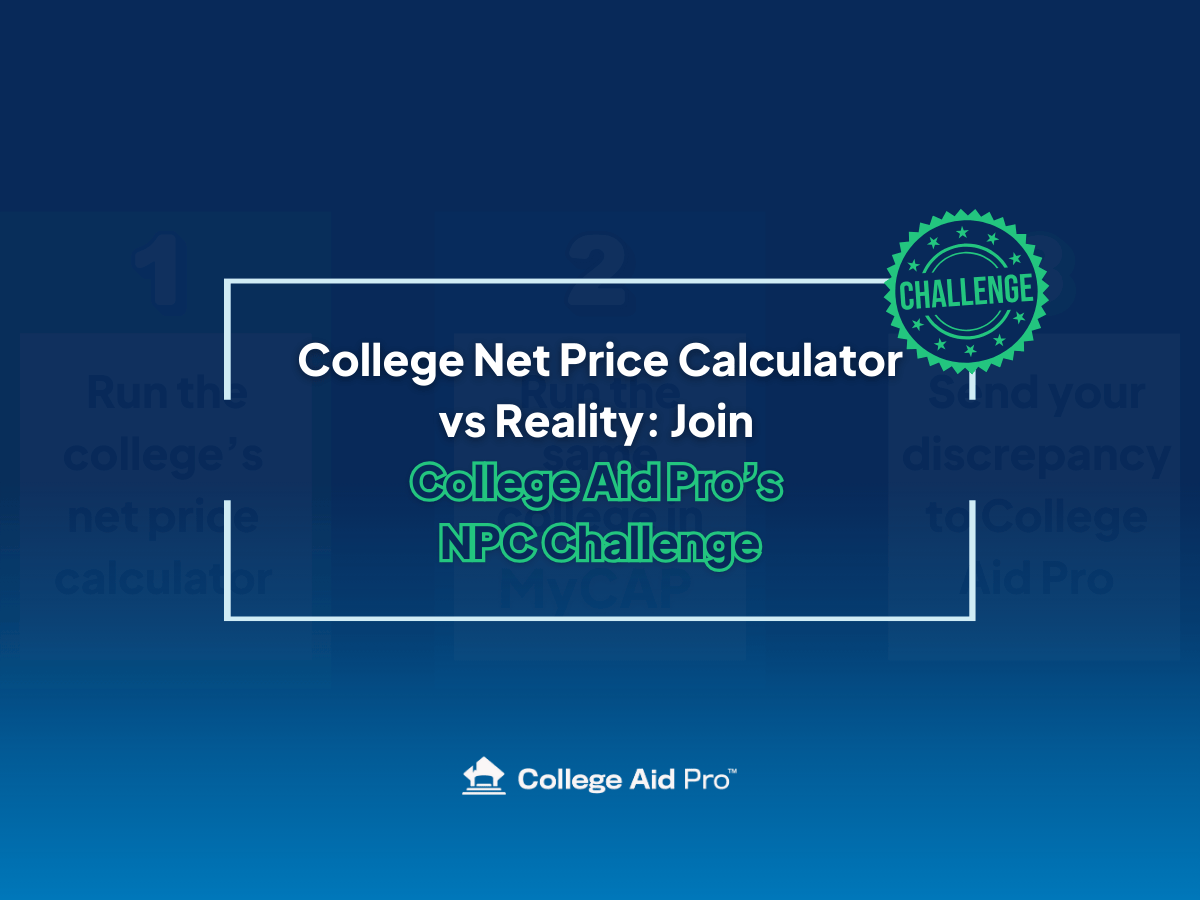High SAT scores can be very advantageous in your student’s college search process. They can open up new possibilities when it comes to college admission and merit scholarships. We will discuss both here.
High SAT Scores & College Admission
After your student has taken their first SAT test, you will have a much better idea of where to focus your efforts for college admission. This is done by comparing your student’s SAT score to the school’s published mid-50% SAT score range.
Where do you find the mid-50% SAT test score range? Most colleges will post this somewhere on their website, but it can be easier to use a site like collegedata.com for this information.
When you are looking at a specific college on collegedata.com, you can find the mid-50% SAT score ranges (or the ACT score range) in the Qualifications of Enrolled Freshmen.
The mid-50% SAT test score range can be the main way to figure out difficulty of admission for a particular school. You have probably heard the advice that your student should have target, reach and safety schools. You can determine these categories primarily by looking at the mid-50% score range.
- If your student’s score is above the mid-50% range, that may be a Safety school
- If your student’s score is within the mid-50% range, that may be a Target school
- If your student’s score is below the mid-50% range, that may be a Reach school
To further determine reach, target and safety categories, you will want to look at the percent of applicants admitted and any further admissions details the school provides around admitted applicants’ GPA and class rank.
Big Fish In A Small Pond vs Small Fish In A Big Pond
The other thing to consider when comparing a student against a college’s admission profile is where the student would be most comfortable – Do they want to be a big fish in a small pond or a small fish in a big pond?
Will your student be more comfortable being one of the “smartest students in the room” or would they prefer to just blend into a room full of smart people?
The difference in preference can totally change the schools you look at, with one exception that we will discuss later.
Let’s look at an example. Our example student has a 1540 SAT score, 780 Math and 760 EBRW. If we search for colleges where that student will fall into the mid-50% score range, here are a few of the colleges we will find:
All are Ivy League or other top-tier universities where this student would be a small fish in a big pond because every student will be top-of-the-class smart.
Then, if we instead look for schools where this student falls above the mid-50% score range, we will find a wide variety of schools, depending on just how far above the mid-50% range we look. Here are a few of the schools we will find:
- Macalester College
- University of Minnesota
- College of William and Mary
- Boston College
- Boston University
- Colgate University
- NYU
- Illinois Wesleyan University
- Davidson College
- Villanova University
- University of Florida
And this list will go on and on – starting with schools where this student will be more of a medium fish in a medium pond and down to schools where they will truly be a very big fish in a small pond.
If your student is willing to be that big fish in a small pond, they will have a much greater chance at high merit-based aid.
Of course you may be wondering how your student will get the level of rigor they need if they are on the top end of the applicant scale. That’s where honors colleges and honors programs can make the difference.
Honors Colleges & Honors Programs
Many colleges, ranging from the largest public universities down to small private colleges, have honors colleges or honors programs.
What’s the difference between an honors college and an honors program? The quick answer is “not much”. Often the larger universities have honors colleges that have a wide cross-campus span and maybe also have honors programs within their existing colleges like business, engineering, arts & sciences, etc. Smaller private colleges tend to have honors programs. However, my oldest daughter attended an honors college at a private university with around 4,000 undergraduates. As a “college”, it had its own building where all the honors classes were held.
These colleges/programs are set up to allow a school that caters to a wider range of students to provide the level of rigor that a top student needs. They are usually very writing intensive, thinking intensive and project intensive.
High SAT scores (or high ACT scores) and high GPAs are the primary factors used for admission to honors programs and honors colleges.
There are often special merit scholarships reserved for those students admitted to the honors college or program.
High SAT Scores & Merit Scholarships
I just mentioned that honors colleges and programs often provide separate merit scholarships. These are often smaller, supplemental merit scholarships.
In general, high SAT scores will make a student eligible for the best merit scholarships offered by a school.
The way colleges award merit scholarships can differ greatly. Some offer a grid of specific amounts automatically awarded for specific SAT/ACT scores, either alone or combined with GPA. Others only offer competitively awarded scholarships that may specify a specific minimum SAT score (or ACT score) needed to be eligible to compete.
If your student has a high SAT score, you will want to get a feel for what scholarships that SAT score makes them eligible for at what colleges. You can start by searching college to college, but this takes a long time and you won’t know what is offered by the schools you aren’t aware of.
In general, students who fall in the top 25% of applicants will be in the best position to receive good merit scholarships from a college.
A Tool to Help Find the Colleges That Will Offer the Best Merit Scholarships
Recognizing that a need existed to be able to easily find merit scholarships that students would qualify for, we created MyCAP. Here you can enter your student’s statistics and preferences to find the schools that offer merit scholarships your student will qualify for automatically or will qualify to compete for. In fact, MyCAP makes it super easy by projecting the best automatic scholarships your student will qualify for at each school.
For the example student I mentioned above – 1540 SAT Score and I added a 3.8 unweighted GPA, I searched in the states of AZ, CA, CO, ID, NV, OR and WA for scholarships in the amounts of half tuition and more, full tuition and full ride. I also said this student’s home state was California (makes a difference for in-state vs out-of-state scholarships).
I found 71 colleges projecting automatic scholarships for this student.
This example student could potentially qualify for:
- University of Arizona – up to $20,000 per year
- Loyola Marymount University – $30,000 per year Presidential Scholarship
- Occidental College – $25,000 Dungan Merit Scholarship (but only offered to one student per year, so chances are low)
- Santa Clara University – $40,000 per year Robert Warren Scholarships (student is well above the minimum SAT score required)
- Soka University – $20,000 per year John D. Montgomery Scholarship
- University of San Diego – Up to $25,000 Undergraduate Merit Scholarships
- University of the Pacific – $43,000 per year Powell Scholarship (student well above minimum requirements)
- Lewis & Clark College – Up to $50,000 per year merit scholarships (for the highly competitive Neely Scholarship)
If I were to relax the “standards” for this student and look for colleges where the student falls well above the mid-50% SAT scores, using the same search criteria I talked about above, this student would qualify for even more great merit scholarships. It all depends on what kind of schools your student is interested in attending.
If this student also happened to take the PSAT test Junior year of high school and scored high enough to qualify as a National Merit semi-finalist or finalist, this would open up a whole additional category of scholarships. Many colleges offer very large scholarships to National Merit finalists and semi-finalists (in addition to the scholarships offered directly through the National Merit Scholarship Corporation). These are also included in the Merit Scholarship List tool.
To sum it up, high SAT scores can be an advantage to the student both in college admissions and in receiving great merit scholarships directly from colleges. These high scores will either help a student qualify for admission at a very selective and prestigious college (most of which do not offer large merit scholarships) or will help a student qualify for very large merit scholarships at less selective colleges. Sign up for MyCAP today to start exploring what great scholarships your student will qualify for.



